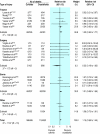Fluid resuscitation with colloid or crystalloid solutions in critically ill patients: a systematic review of randomised trials
- PMID: 9550953
- PMCID: PMC28497
- DOI: 10.1136/bmj.316.7136.961
Fluid resuscitation with colloid or crystalloid solutions in critically ill patients: a systematic review of randomised trials
Abstract
Objective: To determine the effect on mortality of rescuscitation with colloid solutions compared with resuscitation with crystalloids.
Design: Systematic review of randomised controlled trials of resuscitation with colloids compared with crystalloids for volume replacement of critically ill patients; analysis stratified according to patient type and quality of allocation concealment.
Subjects: 37 randomised controlled trials were eligible, of which 26 unconfounded trials compared colloids with crystalloids (n = 1622). (The 10 trials that compared colloid in hypertonic crystalloid with isotonic crystalloid (n = 1422) and one trial that compared colloid in isotonic crystalloid with hypertonic crystalloid (n = 38) are described in the longer version on our website www.bmj.com).
Main outcome measures: Mortality from all causes at end of follow up for each trial.
Results: Resuscitation with colloids was associated with an increased absolute risk of mortality of 4% (95% confidence interval 0% to 8%), or four extra deaths for every 100 patients resuscitated. The summary effect measure shifted towards increased mortality with colloids when only trials with adequate concealment of allocation were included. There was no evidence for differences in effect among patients with different types of injury that required fluid resuscitation.
Conclusions: This systematic review does not support the continued use of colloids for volume replacement in critically ill patients.
Figures
Comment in
- ACP J Club. 1998 Sep-Oct;129(2):32
-
Fluid resuscitation with colloid or crystalloid solutions. Comparing different studies is difficult.BMJ. 1998 Jul 25;317(7153):277; author reply 279. BMJ. 1998. PMID: 9677228 Free PMC article. No abstract available.
-
Fluid resuscitation with colloid or crystalloid solutions. Newer synthetic colloids should not be abandoned.BMJ. 1998 Jul 25;317(7153):277; author reply 279. BMJ. 1998. PMID: 9729070 No abstract available.
-
Fluid resuscitation with colloid or crystalloid solutions. One conclusion could be that hypertonic saline is better than colloids in trauma.BMJ. 1998 Jul 25;317(7153):277-8; author reply 279. BMJ. 1998. PMID: 9729071 No abstract available.
-
Fluid resuscitation with colloid or crystalloid solutions. Eight studies should have been excluded.BMJ. 1998 Jul 25;317(7153):278; author reply 279. BMJ. 1998. PMID: 9729072 No abstract available.
-
Fluid resuscitation with colloid or crystalloid solutions. Use of dextran-70 for fluid resuscitation has been dying out.BMJ. 1998 Jul 25;317(7153):278; author reply 279. BMJ. 1998. PMID: 9729073 No abstract available.
-
Fluid resuscitation with colloid or crystalloid solutions. Conditions and patient groups were too heterogeneous to allow meaningful comparisons.BMJ. 1998 Jul 25;317(7153):278-9; author reply 279. BMJ. 1998. PMID: 9729074 No abstract available.
-
Fluid resuscitation with colloid or crystalloid solutions. Virtually identical article had appeared in Cochrane Library.BMJ. 1998 Jul 25;317(7153):279. BMJ. 1998. PMID: 9729075 No abstract available.
-
Albumin: don't confuse us with the facts. Rather than fulminating, seek to answer the questions raised.BMJ. 1998 Sep 26;317(7162):829-30. doi: 10.1136/bmj.317.7162.829. BMJ. 1998. PMID: 9748170 Free PMC article. No abstract available.
References
-
- Bickell WH, Wall MJ, Pepe PE, Martin R, Ginger VF, Allen MK, et al. Immediate versus delayed resuscitation for hypotensive patients with penetrating torso injuries. N Engl J Med. 1994;331:1105–1109. - PubMed
-
- Vermeulen LC, Ratko TA, Erstad BL, Brecher ME, Matuszewski KA. A paradigm for consensus. The university hospital consortium guidelines for the use of albumin, nonprotein colloid, and crystalloid solutions. Arch Intern Med. 1995;155:373–379. - PubMed
-
- Armstrong RF, Bullen C, Cohen SL, Singer M, Webb AR. Critical care algorithms. Oxford: Oxford Medical Publications, Oxford University Press; 1994.
-
- Yim JM, Vermeulen LC, Erstad BL, Matuszewski KA, Burnett DA, Vlasses PH. Albumin and nonprotein colloid solution use in US academic health centers. Arch Intern Med. 1995;155:2450–2455. - PubMed
-
- Fakhry SM, Alexander J, Smith D, Meyer AA, Peterson HD. Regional and institutional variation in burn care. J Burn Care Rehabil. 1995;16:86–90. - PubMed
Publication types
MeSH terms
Substances
LinkOut - more resources
Full Text Sources
Medical


